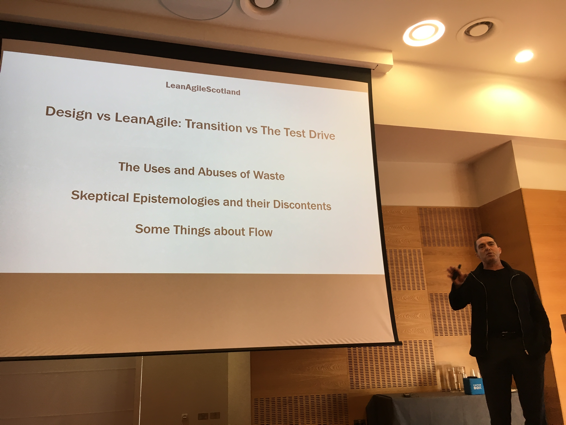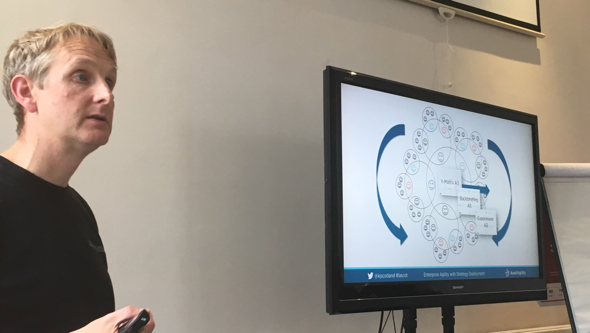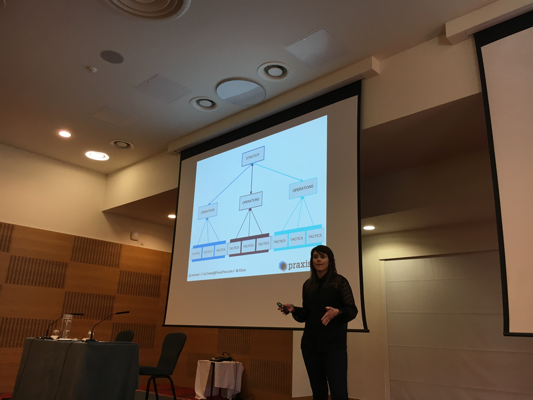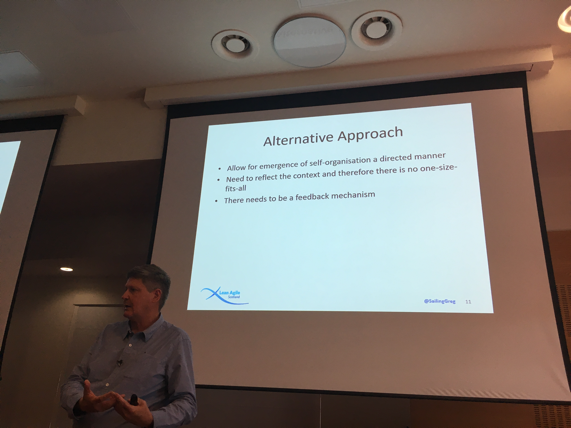Once again, Lean Agile Scotland was an excellent conference full of thought-provoking ideas and stimulating conversations. It was a pleasure to attend and speak at the event. I gained numerous insights; here are some of the most interesting.
Design or Lean Agile?
At the start of the second day, Cameron Tonkinwise challenged the audience with his keynote by contrasting Agile methods with the process of “design.” Although his familiarity with Agile in the workplace is limited, Cameron has a deep knowledge of design and its philosophical underpinnings. For him, design is a creative process that, by integrating ideation, prejudgment, and early evaluation, supports innovative leaps.
Cameron argued that Agile, because of its emphasis on rapid iteration and trial-and-error, is incapable of similar innovation. Instead, Agile focuses on incremental improvements which generate a lot of waste. Teams build more and more “stuff” and they discover what value is, not from conceptualization and reasoning, but by testing it with users in the real world. As many of us have learned, this can be very wasteful.
It was a powerful critique, but it didn’t stop there. Cameron argued that Agile promotes the “corrosive cynicism of empiricism” by assuming that mental models and expert judgments are irrelevant. Instead, reality is defined by what we learn from new software deployments and how they change the behavior of users. I was stunned by how well his argument resonated with me; I have become concerned by the declining importance of expert knowledge, but I never conflated that trend with Agile practices.

Cameron Tonkinwise explored the difference between Lean, Agile, and Design.
If we believe expert judgement has value, how do we leverage it in our software development processes? What can we do to address the problem? Cameron recommended changing our metaphors; we need to emphasize experimentation and exploration over testing and iterating. He encouraged us to create discourse with users and involve them in co-creating the future. These are powerful, tangible suggestions. I was very pleased with them as they reflect what I’ve come to believe after many years in the industry, but have never expressed so eloquently. They’re also what we’re trying to do.
Strategy Deployment, Scaling, and Doctrine
Karl Scotland ran a very effective workshop introducing his approach to Strategy Deployment, which he described as collective sense-making. He walked through three interrelated tools: the X-Matrix, which frames aspirations, strategies, tactics, and evidence; the Backbriefing A3, which is used for developing specific operational plans; and the Experiment A3, which defines low-level tactical improvements. All these formats are available as templates on his website and it was exciting to see them in action. The great value they bring is the structured conversations they foster, a point that Karl effectively demonstrated in his workshop.

Karl Scotland deployed his strategy.
Cat Swetel built on these ideas. She described how she used Strategy Deployment to help an organization devise a custom scaling approach. It integrated development and operations, reflected the organization’s specific context, and allowed much more effective performance. Cat effectively explained how Strategy Deployment can work in the real-world and also gave us a fresh look at scaling in context.

Cat Swetel linked strategy, operations, and tactics.
I tried to do something similar in my presentation on Strategy and Doctrine. I argued that the two are synergistic; effective strategies can lead to new and better doctrines, while better doctrines can permit more effective strategies. Therefore, an evolutionary approach is required for each, so that they can change in light of new opportunities and changing circumstances.
Designing Organizations
The evening of the second day, there was a panel discussion involving several of the speakers. The topic was “organizational design” and it explored many different concepts. Esko Kilpi noted that our approach to organizational design has become too reductionist and insufficiently conscious of context. He feels that we need to place more value on connections and networks, the “in between” that is too often ignored. Cameron argued that one of the merits of an organization is the separation it creates. We can view our membership in an organization as separate from who we are as a person and “do work” without “disappearing into work,” a very valuable point. Alex Harms, Sal Freudenberg, and Mike Sutton riffed off of this exchange, adding their own ideas while Jabe Bloom facilitated. I found it all quite valuable. Everyone seemed to agree that organizations should have an “intent” and that those who assume responsibility for their design need to be deliberate about what that intent is and how it is created. What is the organization’s purpose?

Greg Brougham explained how to design a complex organization.
The next day, Greg Brougham built on these ideas. He discussed two examples of successful organizational design using a clear sense of purpose and sensitivity to context. He framed these as examples of emergent complexity. Each was triggered by the deliberate introduction of constraints, boundaries within which the members of the organization self-organized. Some specific examples of constraints were delivering to the customer every two months, focusing on value, and structured approaches to problem-solving. These harnessed the creativity of individuals without dictating solutions, allowing effective complex structures to evolve from initially simple ones. It was very similar to what I had said about evolutionary approaches to Strategy and Doctrine: constraints are the secret sauce that foster self-organization.
I was very grateful to be able to attend Lean Agile Scotland, sit in on these sessions, and have a series of conversations with the speakers. It was a wonderful conference; I cannot wait until next year!